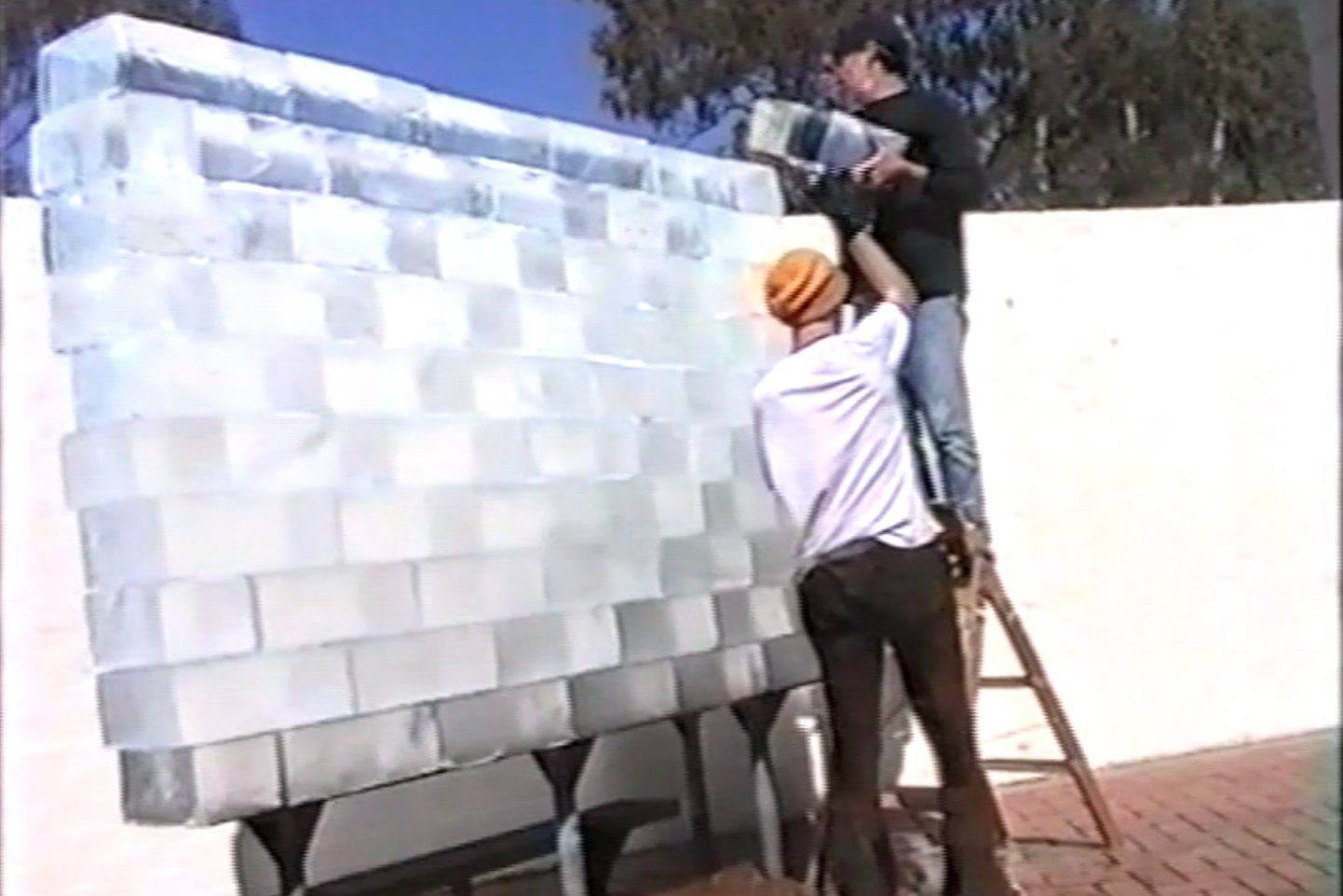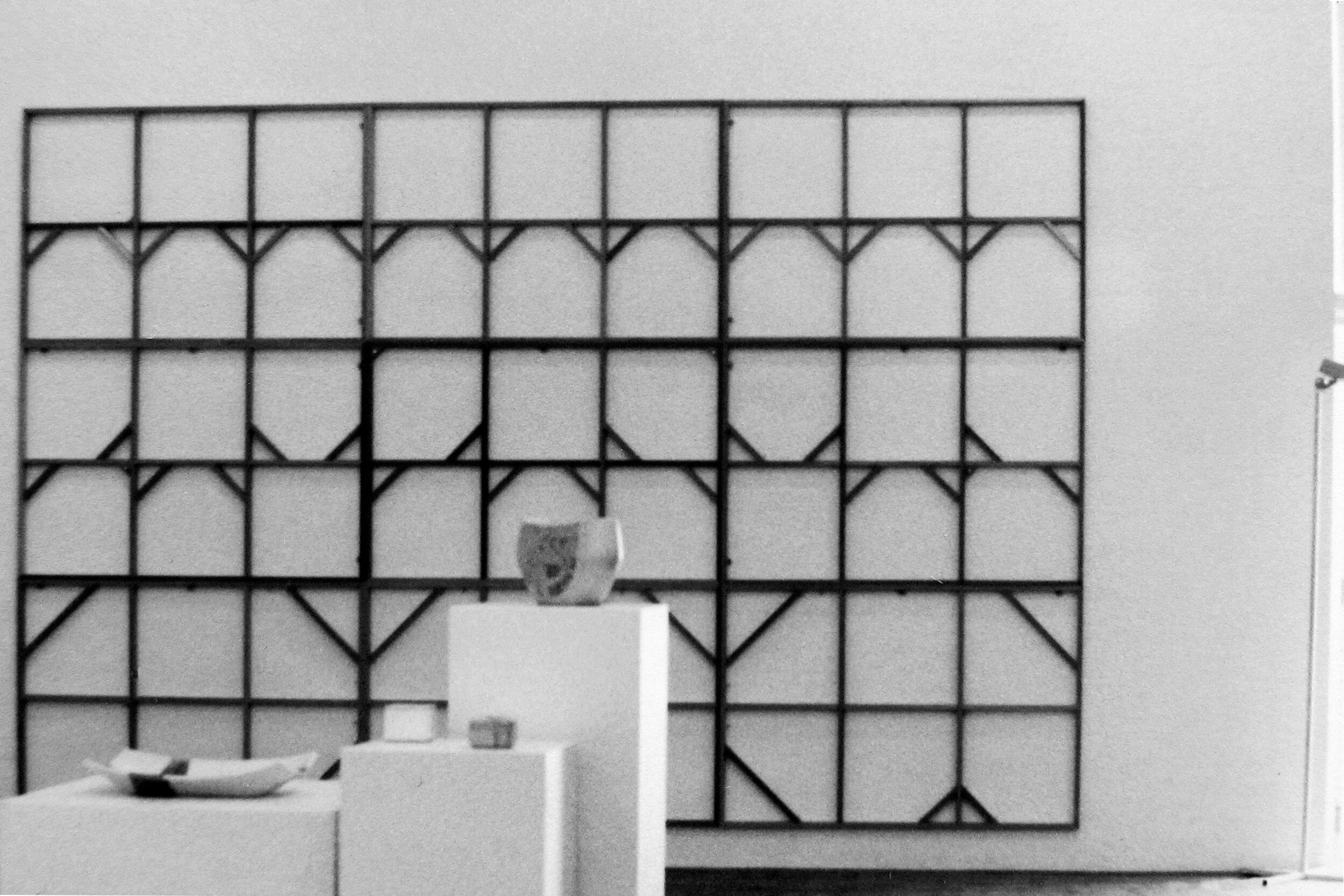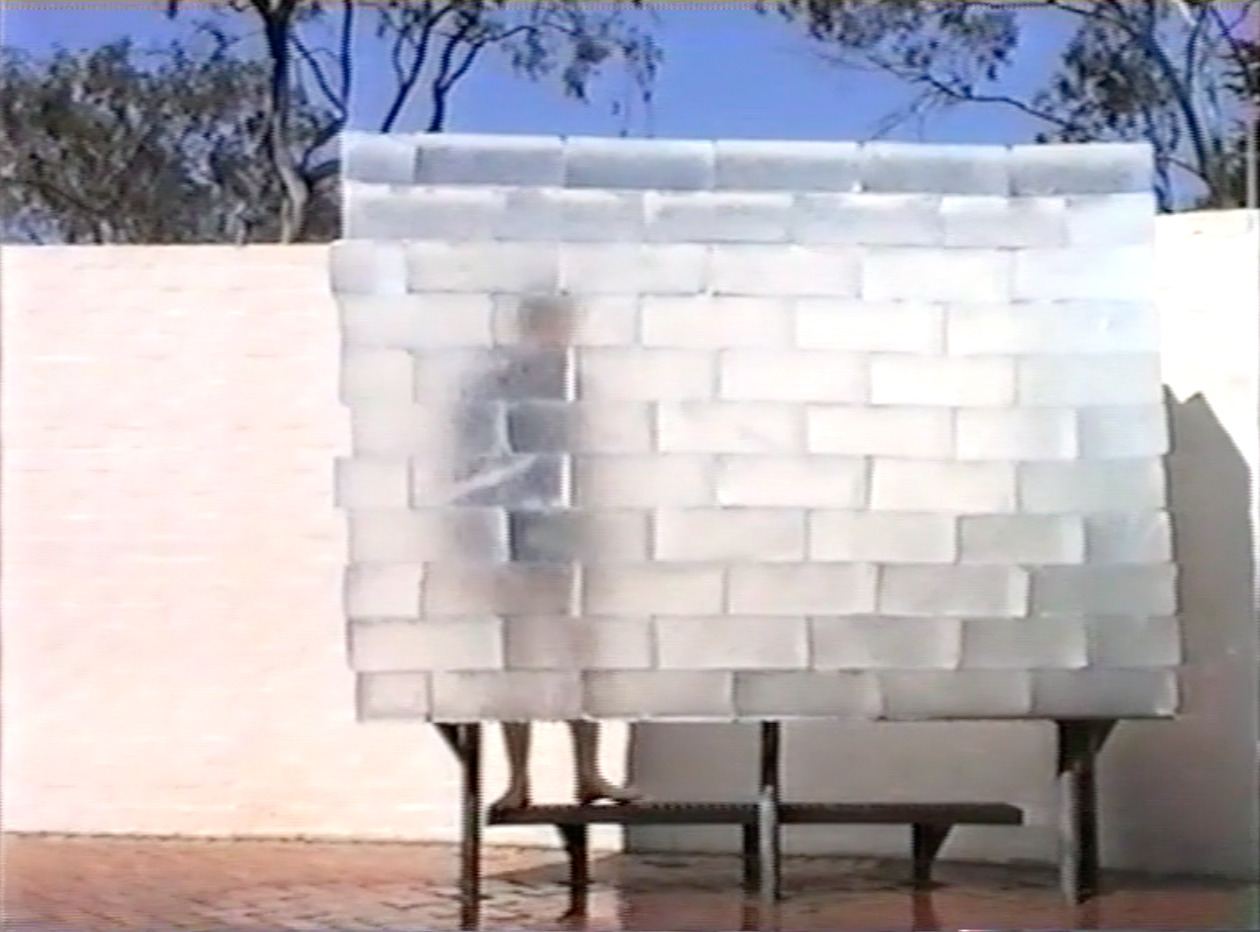Performance Art
A visual art form in which the artist’s body is the main medium of expression. The performance artist does not assume another character, rather the artist postpones their conditioning during the work.
Above: John Reid Asian Ice 1994. ANU School of Art Gallery. See below.
Foreign Aid
John Reid Foreign Aid 1983. Duration: approximately 15 minutes. ‘Canberra’ bricks, blood, excreta, mortar, steel plate and pipe. ‘Canberra School of Art Staff Exhibition’. Canberra School of Art Gallery Courtyard, Canberra, ACT Australia. Photograph: Hanh Tran
Detail of brick wall
Our Lives - Your Style
Documentation of performance to be added when I find it!
Set Piece for Any Ideology
John Reid Set Piece for Any Ideology 1983. Duration: Approximately 30 minutes, 3.30 am. Dimensions: 300.0 x 500.0 cm. Media: Italian carbide rifle, 11 rounds of custom made bullets, Gallery brick wall demarcated inside the Gallery by a set piece of card and cedar frames, metal bolts, noise from discharge of rifle. Venue: Canberra School of Art Gallery and Gallery Courtyard, Canberra, ACT Australia. Photograph: Hanh Tran. John Reid preparing to discharge rifle into Gallery wall from the Gallery Courtyard.
John Reid Set Piece for Any Ideology 1983. Duration: Approximately 30 minutes, 3.30 am. Dimensions: 300.0 x 500.0 cm. Media: Italian carbide rifle, 11 rounds of custom made bullets, Gallery brick wall demarcated inside the Gallery by a set piece of card and cedar frames, metal bolts, noise from discharge of rifle. Venue: Canberra School of Art Gallery and Gallery Courtyard, Canberra, ACT Australia. Photograph: Hanh Tran. John Reid standing in front of work.
John Reid Set Piece for Any Ideology 1983. Duration: Approximately 30 minutes, 3.30 am. Dimensions: 300.0 x 500.0 cm. Media: Italian carbide rifle, 11 rounds of custom made bullets, Gallery brick wall demarcated inside the Gallery by a set piece of card and cedar frames, metal bolts, noise from discharge of rifle. Venue: Canberra School of Art Gallery and Gallery Courtyard, Canberra, ACT Australia. Photograph: Hanh Tran. Back of work - set piece (card with bolted cedar frames) mounted on the Gallery wall - viewed from inside the Gallery .
Set Piece for Any Ideology
An Account
In 1975, Indonesia invaded East Timor. By 1983, the Indonesian military had killed tens of thousands of East Timorese who had resisted the Indonesian occupation.
Early 1983, John Reid conceived of a performance work titled, Set Piece for Any Ideology, as part of a School of Art Staff Exhibition to be held later in the year in the Canberra School of Art Gallery. The work would involve the discharge of a firearm into the gallery wall. This prospect was canvassed with the School of Art Gallery Director who subsequently refused to sanction such an action. John Reid then informed the Gallery Director that he would submit another artwork for the exhibition.
May 1983, Reid submitted Set Piece for Any Ideology to the Canberra School of Art Staff Exhibition ostensibly consisting simply of card glued to a wooden structure bolted to the wall and looking like the back of a stage set. The card and wooden structure was in fact only the back part of Set Piece for Any Ideology. The area of Gallery brick wall delineated by the card was the front part of the work which could be viewed from the Galley Courtyard.
May 6, 3.45 am 1983, (the day the Staff Exhibition opened), John Reid, standing in the courtyard, completed the work by discharging 11 rounds from a rifle into the bricks so prescribed. The sound of gun fire in the night was an essential part of the installation/performance and was intended to wake-up slumbering Canberra residents in the near vicinity.
May 6, 9.00 am 1983, Reid had informed the Gallery Director that he had discharged rounds from a rifle into the gallery wall as a performance component of Set Piece for Any Ideology.
May 6, 9.30 am 1983, the Australian Federal Police, acting on public reports of gunfire, approached the Gallery Director for any information he might have about the incident. Gallery Director told the police that John Reid was responsible of the action and it was undertaken as a part of an artwork for the Staff Exhibition due to open in the Gallery that evening.
The Special Branch of the Federal Police arrived next. They were everywhere, some in white coats and gloves picking up my spent rounds with tweezers. The scale of this response was related to the fact that the Federal Minister for Education, Senator Susan Ryan, was scheduled to open the Staff Exhibition that evening.
The Director of the School summoned John Reid to his office to announce, in the presence of a lawyer from his tertiary education union, that he was suspended from my academic duties at least until the outcome of the police investigation was known.
Matters were proceeding according to plan. In the 1980s, when your subject matter is too important for the slow grind of gallery discourse, the recourse for artists to summon public attention was to attract the mass media by breaking, or flirting with, the law.
John Reid expected that he would be charged with a breach of the law which would lead to an appearance in a magistrate’s court and the attention of court reporters for newspapers. “Why”, he would argue, “is there a fuss over my shooting-up a brick wall while, out of earshot, thousands of our neighbours in East Timor were being murdered”!
Unfortunately, the Federal Police could not bring a charge against him. He could not be charged for discharging a firearm in a public place as the Gallery courtyard was deemed to be private. He could not be charged for disturbing the peace as no one had complained to the police as distinct from informing them. He could not be charged for damage to Commonwealth property as there was no difference between making holes in a gallery wall to present a work for exhibition be it with a drill or a gun.
Set Piece of Any Ideology was a failure, but it’s not too late – now, all one needs to do is post to teir website.
Above: A 35mm format, 5 frame scan of the ANU School of Art Gallery courtyard showing the spatial relationship between Foreign Aid (left) and Set Piece for Any Ideology (right)
Performance for 25 Passing Vehicles
John Reid Performance for 25 Passing Vehicles. Newell Highway, NSW Australia. 1989 1989. Duration: approximately 18 minutes. Newell Highway, NSW Australia. Photograph: Marzena Wasikowska
Performance for 25 Passing Vehicles
Plumwood Mountain. An Australian Journal of Ecopoetry and Ecopoetics.
Volume 1 Number 1 2014. https://plumwoodmountain.com/spotlight-road-kill/
During the university teaching breaks in the winters of 1986-88, I undertook fieldwork in the Strzelecki Desert in South Australia just beyond the corner it shares with New South Wales and Queensland. I potted around in a Volkswagen beetle; its wings clipped to duck under trees and to scurry over sand. It was the means by which I positioned my large format camera and cumbersome tripod. The first trip followed extensive rainfall. The Corner Country had responded with surprising displays of plant and animal life. The other two trips were during successively drier periods and as a consequence kangaroos in particular were drawn to feed from the stock-free strips of land that framed the highways leading to my field location. I noticea significant increase in macropod road kills. It weighed on my mind – a common prerequisite for consideration as subject matter for fine art.
In 1989 I was in the same territory as in the years before, this time with my family travelling in a sixties Valiant Safari station wagon. In its day it was an automotive sensation propelled by a trusty ‘slant-six’ motor. Country mechanics would appear from the dark of their garage pits and pat its bonnet in the sunshine. Fellow Aboriginal travellers would wave from a distance thinking we must be kin. One of my resolutions for this trip was to act artistically on the road kill theme.
My plan was to lie down somewhere in the course of the journey in empathy with, and next to, a kangaroo that had been killed on the road, in all probability, by a heavily loaded truck pushing the speed limit at night. With such momentum (mass x velocity), avoidance procedures at the moment of crisis were out of the question. Time to exercise my intention had all but expired. I had done nothing more than nurture the generic idea and we were heading south with a lust for home.
Last day, 50 kilometres from Dubbo on the Newell Highway, the kangaroo appeared. It was much like any other poor creature that had been knocked to death by a moving vehicle. It was the tableau that struck me. The kangaroo was lying at one end of a road sign that, given my preoccupation, appeared as a crude beam balance – the one used to mete out justice. Although I did not realise it at the time the road sign was mounted upside down. A rare mistake but it was essential for the construction of my concept. Twinning above the fulcrum were more signs to Parkes (‘A well healed town’, I thought, ‘landed gentry’) and to Dubbo (thinking ‘More bare foot; the dispossessed are rallying’). The kangaroo was at the appropriate end of the sign. The inclusion of a privileged, lily-white body like mine at the other end of the beam would complete the pictorial script.
Processing these thoughts took place over a distance of about 4 kilometres. Add a few more to consolidate the work as a performance involving a temporal span to be measured by passing vehicles. The drivers and their passengers would be my primary viewers. I would photographically document the work. A few more kilometres, please, to deal with my reluctance to slow down, stop, step out side into a cold and wet day, take off my clothes and lie down on the side of a highway. This reticence was overcome with the help of a physiological test. It kicks in automatically at the thought of doing a performance artwork. Has my pulse rate quickened? Have I begun to sweat? Are there butterflies in my stomach? Accepting of impromptu variations to travel schedules, my family was easily persuaded that we should turn around and drive back to the sign.
I decided on 25 passing vehicles as the definitive number before I took my position for the work. Had I postponed the decision to some point during its execution it would have been much less. Most of the vehicles were trucks roaring past incapable of responding, I suspect, to a fleeting prospect of crisis. Not one stopped or varied speed - a testament I think to the ease at which we can differentiate between art and life. My body displayed no external signs of trauma. It was aesthetically composed.
For me, the work addresses our high-energy, high-speed careless life style and reasserts the proposition that our fate is bound to the fate of other life around us. The photographic documentation of Performance for 25 Passing Vehicles has had its moment of fame as the hottest selling postcard from the Dubbo Regional Gallery (where the original print resides). Subject to the messages of my own work, each time I see a reproduction of this image I renew my commitment to a night-time curfew for driving in wildlife territory. Despite this I am guilty of killing animals in the course of my personal transportation. I need a new ethical testament on this important matter.
Performance for 25 Passing Vehicles. Newell Highway, NSW Australia. 1989 as exhibited in Figure in the Landscape - 10 Contemporary Ideas, Photospace Gallery, 1990, and subsequently purchased by the Dubbo Regional Gallery, NSW.
Dissent
John Reid Dissent 1981. Duration: Approximately 5 minutes, during the opening of From the Armchair: An essay in medium detail, 6.30pm June 12, 1981.
John Reid Dissent 1981. Duration: Approximately 5 minutes, during the opening of From the Armchair: An essay in medium detail, 6.30pm June 12, 1981.
John Reid Dissent 1981. Duration: Approximately 5 minutes, during the opening of From the Armchair: An essay in medium detail, 6.30pm June 12, 1981.
Asian Ice
ANU Open Day 1994
Australian National University School of Art Gallery Courtyard
Below See photo documentation of: ice acquisition; construction of ice wall; performance (duration 20 minutes); and installation (several days).
All photographs are screenshots taken from a VHS video documentation of preparatory processes and the performance
(30 June 2022)

Lidcombe Ice Company Sydney. Supplier of Ice

Ice blocks cut to specification

Cut blocks ready to load into insulated van and trailer

John Reid receiving blocks to stack in trailer

John Reid stacking blocks

Plan for laying $1,000 worth of custom ice blocks

Construction of ice wall begins on pre-installed steel platform in the ANU School of Art Gallery courtyard

Stacking level 10

Final level 11

Laying last brick, level 11

The completed ice wall

Documentation of performance 'Asian Ice'

Performance commences - John Reid paces on an iron grate behind the wall of ice

'Asian Ice'. Documentation detail

Ice wall collapses twenty minutes into the performance. John Reid leaves the venue

The collapsed ice wall endures as an installation for several days in the gallery courtyard before all the ice melts and terminates the work
Seminar Paper
1980s
John Reid (front left with members of the Photomedia Workshop, ANU School of Art) presses an air cable release to document a seminar paper he presented as a performance (early 1980s), titled Seminar Paper, which involved the planting of tree, Eucalyptus mannifera, commonly known as Brittle Gum. As of 2024, it is flourishing at 18 metres high.
Untaming the Urban
2018
John Reid Suburban Pretext (Performance 1), 2016. 35.0 x 23.0 cm, Digital print.
John Reid Suburban Pretext (Performance 2), 2016. 35.0 x 23.0 cm, Digital print.
John Reid Suburban Pretext (Performance 3), 2016. 35.0 x 23.0 cm, Digital print.
The three performances for the camera (above) were produced for the Symposium, Untaming the Urban from post anthropocentric design to urban ecologies (December 2016), and in response to the Symposium title. [Photographer: Marzena Wasikowska. Roadside assistance: Giselle and Walter Nathan-Truesdale].
Suburban Pretext was undertaken just before the 2016 Symposium to deliver a set of photographs for the coincident exhibition, Untaming the Urban: A Visual Art Response. The artwork was unconstrained by facts or the onus of proof.
At first, I thought of ‘untaming’ in relation to the urban environment: advocating an equitable multi-species occupancy; liberating hermetically sealed buildings; promoting rampant vegetation growth; dismantling of fences; lowering poo-miles; gathering bush tucker on the footpaths.
This inquiry would entail skills I don’t have such as those required for scenario painting or for advanced computing to contrive fantastic images. Alternatively, a performance artwork demands only the artist’s body as the main medium of expression. Unlike in theatre, the performance artist does not assume to be another character, instead, postpones social conditioning to licence atypical behaviour. I take this option and focus on the human being as a significant urban player. This sits well with my vernacular understanding of ‘untaiming’ as scaling back an imposed constraint on living entities to allow reversion to the wild.
As the petting of animals inhibits their development as wild beasts; so too social contracts founded on high-order cognitive notions - let’s say of ethics, morality and individual rights - suppress human wild behaviour that would otherwise have it take its chances any-which-way in the world at large. These repressed beastly urges are managed through the creative arts as a form of slow release; through cathartic domestic dramas intentionally concealed from peer review; and through private fantasies where no law prevails to curtail the fabricated plot.
A metropolis planned principally for humans exhibits the overriding hand of designer domestication. Citizens are committed to pet-like status groomed to trade the untamed, short-lived ways of the beast for senile old age. In any city, there are however complex living systems supporting the manicured lawns and the bitumen expressways. The human creature is itself a turmoil of interconnected life.
SUDDENLY!! There is the sound of gunfire. In a suburban dwelling the family dog is shot for turning wolf and lashing out at its owner. With further inspection comes the realisation that people are continually assaulted behind the veneer of brick bungalows – by other people. Institutions abuse their members. Citizens sit in darkness to witness stories of avarice and exploitation on huge digital screens accompanied by enhanced sound. Beauty is beheld in museums as a substitute for pillage. And where the bed bugs feed on discarded bodily fluids, dreams are made of unfettered desires. Comparable acts of human compassion salve the searing tension.
In response to this scenario, I took the pictures above (Hello, Arthur Boyd).
Performance 1, The Fall, entertains human descent from the trees and the evolutionary consequences (1). Performance 2, The Argument, references animal sexuality and the perverse human desire to be wanted, held and loved (2); and, Performance 3, The Stance, apes a canine Pointer in an emphatic concession to civilization.
Untaming the human and arousing the beast within (3) may not be a good idea. Removing constraints that restrict a full and wholesome acceptance of other species’ life cycles has on the other hand compelling appeal.
1 Helen Fisher’s daring hypothesis in her book, The Sex Contract (1982)
2 The Beatles, Why Don’t We Do It in the Road, 1968
3 No reference intended to the 1982 transformation horror movie, The Beast Within, by Philippe Mora or the novel upon which the film was based by Edward Levy
Bearing Witness - Halls Creek
2013
Halls Creek, Hall, ACT. Site of performance (night-time simulation). This work was presented as part of the 2013 Canberra Centenary program and was a component of Portrait of a Nation, Unmade Edges - Distinctive Places project telling the stories of Tharwa, Hall, Uriarra, Oaks Estate, Pialligo and Stromlo.
























